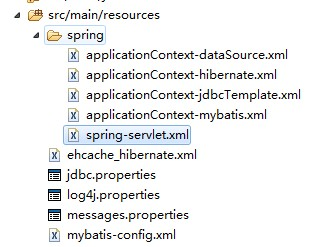一:初始化流程详解
转自:https://my.oschina.net/lichhao/blog/102315
在我们第一次学Servlet编程,学java web的时候,还没有那么多框架。我们开发一个简单的功能要做的事情很简单,就是继承HttpServlet,根据需要重写一下doGet,doPost方法,跳转到我们定义好的jsp页面。Servlet类编写完之后在web.xml里注册这个Servlet类。
除此之外,没有其他了。我们启动web服务器,在浏览器中输入地址,就可以看到浏览器上输出我们写好的页面。为了更好的理解上面这个过程,你需要学习关于Servlet生命周期的三个阶段,就是所谓的“init-service-destroy”。
以上的知识,我觉得对于你理解SpringMVC的设计思想,已经足够了。SpringMVC当然可以称得上是一个复杂的框架,但是同时它又遵循Servlet世界里最简单的法则,那就是“init-service-destroy”。我们要分析SpringMVC的初始化流程,其实就是分析DispatcherServlet类的init()方法,让我们带着这种单纯的观点,打开DispatcherServlet的源码一窥究竟吧。
1.<init-param>配置元素读取
用Eclipse IDE打开DispatcherServlet类的源码,ctrl+T看一下。

DispatcherServlet类的初始化入口方法init()定义在HttpServletBean这个父类中,HttpServletBean类作为一个直接继承于HttpServlet类的类,覆写了HttpServlet类的init()方法,实现了自己的初始化行为。
@Override
public final void init() throws ServletException {
if (logger.isDebugEnabled()) {
logger.debug("Initializing servlet '" + getServletName() + "'");
}
// Set bean properties from init parameters.
try {
PropertyValues pvs = new ServletConfigPropertyValues(getServletConfig(), this.requiredProperties);
BeanWrapper bw = PropertyAccessorFactory.forBeanPropertyAccess(this);
ResourceLoader resourceLoader = new ServletContextResourceLoader(getServletContext());
bw.registerCustomEditor(Resource.class, new ResourceEditor(resourceLoader, this.environment));
initBeanWrapper(bw);
bw.setPropertyValues(pvs, true);
}
catch (BeansException ex) {
logger.error("Failed to set bean properties on servlet '" + getServletName() + "'", ex);
throw ex;
}
// Let subclasses do whatever initialization they like.
initServletBean();
if (logger.isDebugEnabled()) {
logger.debug("Servlet '" + getServletName() + "' configured successfully");
}
}
这里的initServletBean()方法在HttpServletBean类中是一个没有任何实现的空方法,它的目的就是留待子类实现自己的初始化逻辑,也就是我们常说的模板方法设计模式。SpringMVC在此生动的运用了这个模式,init()方法就是模版方法模式中的模板方法,SpringMVC真正的初始化过程,由子类FrameworkServlet中覆写的initServletBean()方法触发。
再看一下init()方法内被try,catch块包裹的代码,里面涉及到BeanWrapper,PropertyValues,ResourceEditor这些Spring内部非常底层的类。要深究具体代码实现上面的细节,需要对Spring框架源码具有相当深入的了解。我们这里先避繁就简,从代码效果和设计思想上面来分析这段try,catch块内的代码所做的事情:
- 注册一个字符串到资源文件的编辑器,让Servlet下面的<init-param>配置元素可以使用形如“classpath:”这种方式指定SpringMVC框架bean配置文件的来源。
- 将web.xml中在DispatcherServlet这个Servlet下面的<init-param>配置元素利用JavaBean的方式(即通过setter方法)读取到DispatcherServlet中来。
这两点,我想通过下面一个例子来说明一下。
我在web.xml中注册的DispatcherServlet配置如下:
<!-- springMVC配置开始 -->
<servlet>
<servlet-name>appServlet</servlet-name>
<servlet-class>org.springframework.web.servlet.DispatcherServlet</servlet-class>
<init-param>
<param-name>contextConfigLocation</param-name>
<param-value>classpath:spring/spring-servlet.xml</param-value>
</init-param>
<load-on-startup>1</load-on-startup>
</servlet>
<servlet-mapping>
<servlet-name>appServlet</servlet-name>
<url-pattern>/</url-pattern>
</servlet-mapping>
<!-- springMVC配置结束 -->
可以看到,我注册了一个名为contextConfigLocation的<init-param>元素,其值为“classpath:spring/spring-servlet.xml”,这也是大家常常用来指定SpringMVC配置文件路径的方法。上面那段try,catch块包裹的代码发挥的作用,一个是将“classpath:spring/spring-servlet.xml”这段字符串转换成classpath路径下的一个资源文件,供框架初始化读取配置元素。在我的工程中是在spring文件夹下面的配置文件spring-servlet.xml。

另外一个作用,就是将contextConfigLocation的值读取出来,然后通过setContextConfigLocation()方法设置到DispatcherServlet中,这个setContextConfigLocation()方法是在FrameworkServlet类中定义的,也就是上面继承类图中DispatcherServlet的直接父类。
我们在setContextConfigLocation()方法上面打上一个断点,启动web工程,可以看到下面的调试结果。

HttpServletBean类的作者是大名鼎鼎的Spring之父Rod Johnson。作为POJO编程哲学的大师,他在HttpServletBean这个类的设计中,运用了依赖注入思想完成了<init-param>配置元素的读取。他抽离出HttpServletBean这个类的目的也在于此,就是“以依赖注入的方式来读取Servlet类的<init-param>配置信息”,而且这里很明显是一种setter注入。
明白了HttpServletBean类的设计思想,我们也就知道可以如何从中获益。具体来说,我们继承HttpServletBean类(就像DispatcherServlet做的那样),在类中定义一个属性,为这个属性加上setter方法后,我们就可以在<init-param>元素中为其定义值。在类被初始化后,值就会被注入进来,我们可以直接使用它,避免了样板式的getInitParameter()方法的使用,而且还免费享有Spring中资源编辑器的功能,可以在web.xml中,通过“classpath:”直接指定类路径下的资源文件。
注意,虽然SpringMVC本身为了后面初始化上下文的方便,使用了字符串来声明和设置contextConfigLocation参数,但是将其声明为Resource类型,同样能够成功获取。鼓励读者们自己继承HttpServletBean写一个测试用的Servlet类,并设置一个参数来调试一下,这样能够帮助你更好的理解获取配置参数的过程。
2.容器上下文的建立
上一篇文章中提到过,SpringMVC使用了Spring容器来容纳自己的配置元素,拥有自己的bean容器上下文。在SpringMVC初始化的过程中,非常关键的一步就是要建立起这个容器上下文,而这个建立上下文的过程,发生在FrameworkServlet类中,由上面init()方法中的initServletBean()方法触发。
@Override
protected final void initServletBean() throws ServletException {
getServletContext().log("Initializing Spring FrameworkServlet '" + getServletName() + "'");
if (this.logger.isInfoEnabled()) {
this.logger.info("FrameworkServlet '" + getServletName() + "': initialization started");
}
long startTime = System.currentTimeMillis();
try {
this.webApplicationContext = initWebApplicationContext();
initFrameworkServlet();
}
catch (ServletException ex) {
this.logger.error("Context initialization failed", ex);
throw ex;
}
catch (RuntimeException ex) {
this.logger.error("Context initialization failed", ex);
throw ex;
}
if (this.logger.isInfoEnabled()) {
long elapsedTime = System.currentTimeMillis() - startTime;
this.logger.info("FrameworkServlet '" + getServletName() + "': initialization completed in " +
elapsedTime + " ms");
}
}
initFrameworkServlet()方法是一个没有任何实现的空方法,除去一些样板式的代码,那么这个initServletBean()方法所做的事情已经非常明白:
this.webApplicationContext = initWebApplicationContext();
这一句简单直白的代码,道破了FrameworkServlet这个类,在SpringMVC类体系中的设计目的,它是 用来抽离出建立 WebApplicationContext 上下文这个过程的。
initWebApplicationContext()方法,封装了建立Spring容器上下文的整个过程,方法内的逻辑如下:
- 获取由ContextLoaderListener初始化并注册在ServletContext中的根上下文,记为rootContext
- 如果webApplicationContext已经不为空,表示这个Servlet类是通过编程式注册到容器中的(Servlet 3.0+中的ServletContext.addServlet() ),上下文也由编程式传入。若这个传入的上下文还没被初始化,将rootContext上下文设置为它的父上下文,然后将其初始化,否则直接使用。
- 通过wac变量的引用是否为null,判断第2步中是否已经完成上下文的设置(即上下文是否已经用编程式方式传入),如果wac==null成立,说明该Servlet不是由编程式注册到容器中的。此时以contextAttribute属性的值为键,在ServletContext中查找上下文,查找得到,说明上下文已经以别的方式初始化并注册在contextAttribute下,直接使用。
- 检查wac变量的引用是否为null,如果wac==null成立,说明2、3两步中的上下文初始化策略都没成功,此时调用createWebApplicationContext(rootContext),建立一个全新的以rootContext为父上下文的上下文,作为SpringMVC配置元素的容器上下文。大多数情况下我们所使用的上下文,就是这个新建的上下文。
- 以上三种初始化上下文的策略,都会回调onRefresh(ApplicationContext context)方法(回调的方式根据不同策略有不同),onRefresh方法在DispatcherServlet类中被覆写,以上面得到的上下文为依托,完成SpringMVC中默认实现类的初始化。
- 最后,将这个上下文发布到ServletContext中,也就是将上下文以一个和Servlet类在web.xml中注册名字有关的值为键,设置为ServletContext的一个属性。你可以通过改变publishContext的值来决定是否发布到ServletContext中,默认为true。
以上面6点跟踪FrameworkServlet类中的代码,可以比较清晰的了解到整个容器上下文的建立过程,也就能够领会到FrameworkServlet类的设计目的,它是用来建立一个和Servlet关联的Spring容器上下文,并将其注册到ServletContext中的。跳脱开SpringMVC体系,我们也能通过继承FrameworkServlet类,得到与Spring容器整合的好处,FrameworkServlet和HttpServletBean一样,是一个可以独立使用的类。整个SpringMVC设计中,处处体现开闭原则,这里显然也是其中一点。
3.初始化SpringMVC默认实现类
初始化流程在FrameworkServlet类中流转,建立了上下文后,通过onRefresh(ApplicationContext context)方法的回调,进入到DispatcherServlet类中。
@Override
protected void onRefresh(ApplicationContext context) {
initStrategies(context);
}
DispatcherServlet类覆写了父类FrameworkServlet中的onRefresh(ApplicationContext context)方法,提供了SpringMVC各种编程元素的初始化。当然这些编程元素,都是作为容器上下文中一个个bean而存在的。具体的初始化策略,在initStrategies()方法中封装。
protected void initStrategies(ApplicationContext context) {
initMultipartResolver(context);
initLocaleResolver(context);
initThemeResolver(context);
initHandlerMappings(context);
initHandlerAdapters(context);
initHandlerExceptionResolvers(context);
initRequestToViewNameTranslator(context);
initViewResolvers(context);
initFlashMapManager(context);
}
我们以其中initHandlerMappings(context)方法为例,分析一下这些SpringMVC编程元素的初始化策略,其他的方法,都是以类似的策略初始化的。
private void initHandlerMappings(ApplicationContext context) {
this.handlerMappings = null;
if (this.detectAllHandlerMappings) {
// Find all HandlerMappings in the ApplicationContext, including ancestor contexts.
Map<String, HandlerMapping> matchingBeans =
BeanFactoryUtils.beansOfTypeIncludingAncestors(context, HandlerMapping.class, true, false);
if (!matchingBeans.isEmpty()) {
this.handlerMappings = new ArrayList<HandlerMapping>(matchingBeans.values());
// We keep HandlerMappings in sorted order.
OrderComparator.sort(this.handlerMappings);
}
}
else {
try {
HandlerMapping hm = context.getBean(HANDLER_MAPPING_BEAN_NAME, HandlerMapping.class);
this.handlerMappings = Collections.singletonList(hm);
}
catch (NoSuchBeanDefinitionException ex) {
// Ignore, we'll add a default HandlerMapping later.
}
}
// Ensure we have at least one HandlerMapping, by registering
// a default HandlerMapping if no other mappings are found.
if (this.handlerMappings == null) {
this.handlerMappings = getDefaultStrategies(context, HandlerMapping.class);
if (logger.isDebugEnabled()) {
logger.debug("No HandlerMappings found in servlet '" + getServletName() + "': using default");
}
}
}
detectAllHandlerMappings变量默认为true,所以在初始化HandlerMapping接口默认实现类的时候,会把上下文中所有HandlerMapping类型的Bean都注册在handlerMappings这个List变量中。如果你手工将其设置为false,那么将尝试获取名为handlerMapping的Bean,新建一个只有一个元素的List,将其赋给handlerMappings。如果经过上面的过程,handlerMappings变量仍为空,那么说明你没有在上下文中提供自己HandlerMapping类型的Bean定义。此时,SpringMVC将采用默认初始化策略来初始化handlerMappings。
点进去getDefaultStrategies看一下。
@SuppressWarnings("unchecked")
protected <T> List<T> getDefaultStrategies(ApplicationContext context, Class<T> strategyInterface) {
String key = strategyInterface.getName();
String value = defaultStrategies.getProperty(key);
if (value != null) {
String[] classNames = StringUtils.commaDelimitedListToStringArray(value);
List<T> strategies = new ArrayList<T>(classNames.length);
for (String className : classNames) {
try {
Class<?> clazz = ClassUtils.forName(className, DispatcherServlet.class.getClassLoader());
Object strategy = createDefaultStrategy(context, clazz);
strategies.add((T) strategy);
}
catch (ClassNotFoundException ex) {
throw new BeanInitializationException(
"Could not find DispatcherServlet's default strategy class [" + className +
"] for interface [" + key + "]", ex);
}
catch (LinkageError err) {
throw new BeanInitializationException(
"Error loading DispatcherServlet's default strategy class [" + className +
"] for interface [" + key + "]: problem with class file or dependent class", err);
}
}
return strategies;
}
else {
return new LinkedList<T>();
}
}
它是一个范型的方法,承担所有SpringMVC编程元素的默认初始化策略。方法的内容比较直白,就是以传递类的名称为键,从defaultStrategies这个Properties变量中获取实现类,然后反射初始化。
需要说明一下的是defaultStrategies变量的初始化,它是在DispatcherServlet的静态初始化代码块中加载的。
private static final Properties defaultStrategies;
static {
// Load default strategy implementations from properties file.
// This is currently strictly internal and not meant to be customized
// by application developers.
try {
ClassPathResource resource = new ClassPathResource(DEFAULT_STRATEGIES_PATH, DispatcherServlet.class);
defaultStrategies = PropertiesLoaderUtils.loadProperties(resource);
}
catch (IOException ex) {
throw new IllegalStateException("Could not load 'DispatcherServlet.properties': " + ex.getMessage());
}
}
private static final String DEFAULT_STRATEGIES_PATH = "DispatcherServlet.properties";
这个DispatcherServlet.properties里面,以键值对的方式,记录了SpringMVC默认实现类,它在spring-webmvc-3.1.3.RELEASE.jar这个jar包内,在org.springframework.web.servlet包里面。
# Default implementation classes for DispatcherServlet's strategy interfaces.
# Used as fallback when no matching beans are found in the DispatcherServlet context.
# Not meant to be customized by application developers.
org.springframework.web.servlet.LocaleResolver=org.springframework.web.servlet.i18n.AcceptHeaderLocaleResolver
org.springframework.web.servlet.ThemeResolver=org.springframework.web.servlet.theme.FixedThemeResolver
org.springframework.web.servlet.HandlerMapping=org.springframework.web.servlet.handler.BeanNameUrlHandlerMapping,
org.springframework.web.servlet.mvc.annotation.DefaultAnnotationHandlerMapping
org.springframework.web.servlet.HandlerAdapter=org.springframework.web.servlet.mvc.HttpRequestHandlerAdapter,
org.springframework.web.servlet.mvc.SimpleControllerHandlerAdapter,
org.springframework.web.servlet.mvc.annotation.AnnotationMethodHandlerAdapter
org.springframework.web.servlet.HandlerExceptionResolver=org.springframework.web.servlet.mvc.annotation.AnnotationMethodHandlerExceptionResolver,
org.springframework.web.servlet.mvc.annotation.ResponseStatusExceptionResolver,
org.springframework.web.servlet.mvc.support.DefaultHandlerExceptionResolver
org.springframework.web.servlet.RequestToViewNameTranslator=org.springframework.web.servlet.view.DefaultRequestToViewNameTranslator
org.springframework.web.servlet.ViewResolver=org.springframework.web.servlet.view.InternalResourceViewResolver
org.springframework.web.servlet.FlashMapManager=org.springframework.web.servlet.support.SessionFlashMapManager
至此,我们分析完了initHandlerMappings(context)方法的执行过程,其他的初始化过程与这个方法非常类似。所有初始化方法执行完后,SpringMVC正式完成初始化,静静等待Web请求的到来。
4.总结
回顾整个SpringMVC的初始化流程,我们看到,通过HttpServletBean、FrameworkServlet、DispatcherServlet三个不同的类层次,SpringMVC的设计者将三种不同的职责分别抽象,运用模版方法设计模式分别固定在三个类层次中。其中HttpServletBean完成的是<init-param>配置元素的依赖注入,FrameworkServlet完成的是容器上下文的建立,DispatcherServlet完成的是SpringMVC具体编程元素的初始化策略。
二、请求转发流程详解
转自:https://my.oschina.net/lichhao/blog/104943
SpringMVC完成初始化流程之后,就进入Servlet标准生命周期的第二个阶段,即“service”阶段。在“service”阶段中,每一次Http请求到来,容器都会启动一个请求线程,通过service()方法,委派到doGet()或者doPost()这些方法,完成Http请求的处理。
在初始化流程中,SpringMVC巧妙的运用依赖注入读取参数,并最终建立一个与容器上下文相关联的Spring子上下文。这个子上下文,就像Struts2中xwork容器一样,为接下来的Http处理流程中各种编程元素提供了容身之所。如果说将Spring上下文关联到Servlet容器中,是SpringMVC框架的第一个亮点,那么在请求转发流程中,SpringMVC对各种处理环节编程元素的抽象,就是另外一个独具匠心的亮点。
Struts2采取的是一种完全和Web容器隔离和解耦的事件机制。诸如Action对象、Result对象、Interceptor对象,这些都是完全脱离Servlet容器的编程元素。Struts2将数据流和事件处理完全剥离开来,从Http请求中读取数据后,下面的事件处理流程就只依赖于这些数据,而完全不知道有Web环境的存在。
反观SpringMVC,无论HandlerMapping对象、HandlerAdapter对象还是View对象,这些核心的接口所定义的方法中,HttpServletRequest和HttpServletResponse对象都是直接作为方法的参数出现的。这也就意味着,框架的设计者,直接将SpringMVC框架和容器绑定到了一起。或者说,整个SpringMVC框架,都是依托着Servlet容器元素来设计的。下面就来看一下,源码中是如何体现这一点的。
1.请求转发的入口
就像任何一个注册在容器中的Servlet一样,DispatcherServlet也是通过自己的service()方法来接收和转发Http请求到具体的doGet()或doPost()这些方法的。以一次典型的GET请求为例,经过HttpServlet基类中service()方法的委派,请求会被转发到doGet()方法中。doGet()方法,在DispatcherServlet的父类FrameworkServlet类中被覆写。
@Override
protected final void doGet(HttpServletRequest request, HttpServletResponse response)
throws ServletException, IOException {
processRequest(request, response);
}
可以看到,这里只是简单的转发到processRequest()这个方法。
protected final void processRequest(HttpServletRequest request, HttpServletResponse response)
throws ServletException, IOException {
long startTime = System.currentTimeMillis();
Throwable failureCause = null;
// Expose current LocaleResolver and request as LocaleContext.
LocaleContext previousLocaleContext = LocaleContextHolder.getLocaleContext();
LocaleContextHolder.setLocaleContext(buildLocaleContext(request), this.threadContextInheritable);
// Expose current RequestAttributes to current thread.
RequestAttributes previousRequestAttributes = RequestContextHolder.getRequestAttributes();
ServletRequestAttributes requestAttributes = null;
if (previousRequestAttributes == null || previousRequestAttributes.getClass().equals(ServletRequestAttributes.class)) {
requestAttributes = new ServletRequestAttributes(request);
RequestContextHolder.setRequestAttributes(requestAttributes, this.threadContextInheritable);
}
if (logger.isTraceEnabled()) {
logger.trace("Bound request context to thread: " + request);
}
try {
doService(request, response);
}
catch (ServletException ex) {
failureCause = ex;
throw ex;
}
catch (IOException ex) {
failureCause = ex;
throw ex;
}
catch (Throwable ex) {
failureCause = ex;
throw new NestedServletException("Request processing failed", ex);
}
finally {
// Clear request attributes and reset thread-bound context.
LocaleContextHolder.setLocaleContext(previousLocaleContext, this.threadContextInheritable);
if (requestAttributes != null) {
RequestContextHolder.setRequestAttributes(previousRequestAttributes, this.threadContextInheritable);
requestAttributes.requestCompleted();
}
if (logger.isTraceEnabled()) {
logger.trace("Cleared thread-bound request context: " + request);
}
if (logger.isDebugEnabled()) {
if (failureCause != null) {
this.logger.debug("Could not complete request", failureCause);
}
else {
this.logger.debug("Successfully completed request");
}
}
if (this.publishEvents) {
// Whether or not we succeeded, publish an event.
long processingTime = System.currentTimeMillis() - startTime;
this.webApplicationContext.publishEvent(
new ServletRequestHandledEvent(this,
request.getRequestURI(), request.getRemoteAddr(),
request.getMethod(), getServletConfig().getServletName(),
WebUtils.getSessionId(request), getUsernameForRequest(request),
processingTime, failureCause));
}
}
}
代码有点长,理解的要点是以doService()方法为区隔,前一部分是将当前请求的Locale对象和属性,分别设置到LocaleContextHolder和RequestContextHolder这两个抽象类中的ThreadLocal对象中,也就是分别将这两个东西和请求线程做了绑定。在doService()处理结束后,再恢复回请求前的LocaleContextHolder和RequestContextHolder,也即解除线程绑定。每次请求处理结束后,容器上下文都发布了一个ServletRequestHandledEvent事件,你可以注册监听器来监听该事件。
可以看到,processRequest()方法只是做了一些线程安全的隔离,真正的请求处理,发生在doService()方法中。点开FrameworkServlet类中的doService()方法。
protected abstract void doService(HttpServletRequest request, HttpServletResponse response)
throws Exception;
又是一个抽象方法,这也是SpringMVC类设计中的惯用伎俩:父类抽象处理流程,子类给予具体的实现。真正的实现是在DispatcherServlet类中。
让我们接着看DispatcherServlet类中实现的doService()方法。
@Override
protected void doService(HttpServletRequest request, HttpServletResponse response) throws Exception {
if (logger.isDebugEnabled()) {
String requestUri = urlPathHelper.getRequestUri(request);
logger.debug("DispatcherServlet with name '" + getServletName() + "' processing " + request.getMethod() +
" request for [" + requestUri + "]");
}
// Keep a snapshot of the request attributes in case of an include,
// to be able to restore the original attributes after the include.
Map<String, Object> attributesSnapshot = null;
if (WebUtils.isIncludeRequest(request)) {
logger.debug("Taking snapshot of request attributes before include");
attributesSnapshot = new HashMap<String, Object>();
Enumeration<?> attrNames = request.getAttributeNames();
while (attrNames.hasMoreElements()) {
String attrName = (String) attrNames.nextElement();
if (this.cleanupAfterInclude || attrName.startsWith("org.springframework.web.servlet")) {
attributesSnapshot.put(attrName, request.getAttribute(attrName));
}
}
}
// Make framework objects available to handlers and view objects.
request.setAttribute(WEB_APPLICATION_CONTEXT_ATTRIBUTE, getWebApplicationContext());
request.setAttribute(LOCALE_RESOLVER_ATTRIBUTE, this.localeResolver);
request.setAttribute(THEME_RESOLVER_ATTRIBUTE, this.themeResolver);
request.setAttribute(THEME_SOURCE_ATTRIBUTE, getThemeSource());
FlashMap inputFlashMap = this.flashMapManager.retrieveAndUpdate(request, response);
if (inputFlashMap != null) {
request.setAttribute(INPUT_FLASH_MAP_ATTRIBUTE, Collections.unmodifiableMap(inputFlashMap));
}
request.setAttribute(OUTPUT_FLASH_MAP_ATTRIBUTE, new FlashMap());
request.setAttribute(FLASH_MAP_MANAGER_ATTRIBUTE, this.flashMapManager);
try {
doDispatch(request, response);
}
finally {
// Restore the original attribute snapshot, in case of an include.
if (attributesSnapshot != null) {
restoreAttributesAfterInclude(request, attributesSnapshot);
}
}
}
几个requet.setAttribute()方法的调用,将前面在初始化流程中实例化的对象设置到http请求的属性中,供下一步处理使用,其中有容器的上下文对象、本地化解析器等SpringMVC特有的编程元素。不同于Struts2中的ValueStack,SpringMVC的数据并没有从HttpServletRequest对象中抽离出来再存进另外一个编程元素,这也跟SpringMVC的设计思想有关。因为从一开始,SpringMVC的设计者就认为,不应该将请求处理过程和Web容器完全隔离。
所以,你可以看到,真正发生请求转发的方法doDispatch()中,它的参数是HttpServletRequest和HttpServletResponse对象。这给我们传递的意思也很明确,从request中能获取到一切请求的数据,从response中,我们又可以往服务器端输出任何响应,Http请求的处理,就应该围绕这两个对象来设计。我们不妨可以将SpringMVC这种设计方案,是从Struts2的过度设计中吸取教训,而向Servlet编程的一种回归和简化。
2.请求转发的抽象描述
接下来让我们看看doDispatch()这个整个请求转发流程中最核心的方法。DispatcherServlet所接收的Http请求,经过层层转发,最终都是汇总到这个方法中来进行最后的请求分发和处理。doDispatch()这个方法的内容,就是SpringMVC整个框架的精华所在。它通过高度抽象的接口,描述出了一个MVC(Model-View-Controller)设计模式的实现方案。Model、View、Controller三种层次的编程元素,在SpringMVC中都有大量的实现类,各种处理细节也是千差万别。但是,它们最后都是由,也都能由doDispatch()方法来统一描述,这就是接口和抽象的威力,万变不离其宗。
先来看一下doDispatch()方法的庐山真面目。
protected void doDispatch(HttpServletRequest request, HttpServletResponse response) throws Exception {
HttpServletRequest processedRequest = request;
HandlerExecutionChain mappedHandler = null;
int interceptorIndex = -1;
try {
ModelAndView mv;
boolean errorView = false;
try {
processedRequest = checkMultipart(request);
// Determine handler for the current request.
mappedHandler = getHandler(processedRequest, false);
if (mappedHandler == null || mappedHandler.getHandler() == null) {
noHandlerFound(processedRequest, response);
return;
}
// Determine handler adapter for the current request.
HandlerAdapter ha = getHandlerAdapter(mappedHandler.getHandler());
// Process last-modified header, if supported by the handler.
String method = request.getMethod();
boolean isGet = "GET".equals(method);
if (isGet || "HEAD".equals(method)) {
long lastModified = ha.getLastModified(request, mappedHandler.getHandler());
if (logger.isDebugEnabled()) {
String requestUri = urlPathHelper.getRequestUri(request);
logger.debug("Last-Modified value for [" + requestUri + "] is: " + lastModified);
}
if (new ServletWebRequest(request, response).checkNotModified(lastModified) && isGet) {
return;
}
}
// Apply preHandle methods of registered interceptors.
HandlerInterceptor[] interceptors = mappedHandler.getInterceptors();
if (interceptors != null) {
for (int i = 0; i < interceptors.length; i++) {
HandlerInterceptor interceptor = interceptors[i];
if (!interceptor.preHandle(processedRequest, response, mappedHandler.getHandler())) {
triggerAfterCompletion(mappedHandler, interceptorIndex, processedRequest, response, null);
return;
}
interceptorIndex = i;
}
}
// Actually invoke the handler.
mv = ha.handle(processedRequest, response, mappedHandler.getHandler());
// Do we need view name translation?
if (mv != null && !mv.hasView()) {
mv.setViewName(getDefaultViewName(request));
}
// Apply postHandle methods of registered interceptors.
if (interceptors != null) {
for (int i = interceptors.length - 1; i >= 0; i--) {
HandlerInterceptor interceptor = interceptors[i];
interceptor.postHandle(processedRequest, response, mappedHandler.getHandler(), mv);
}
}
}
catch (ModelAndViewDefiningException ex) {
logger.debug("ModelAndViewDefiningException encountered", ex);
mv = ex.getModelAndView();
}
catch (Exception ex) {
Object handler = (mappedHandler != null ? mappedHandler.getHandler() : null);
mv = processHandlerException(processedRequest, response, handler, ex);
errorView = (mv != null);
}
// Did the handler return a view to render?
if (mv != null && !mv.wasCleared()) {
render(mv, processedRequest, response);
if (errorView) {
WebUtils.clearErrorRequestAttributes(request);
}
}
else {
if (logger.isDebugEnabled()) {
logger.debug("Null ModelAndView returned to DispatcherServlet with name '" + getServletName() +
"': assuming HandlerAdapter completed request handling");
}
}
// Trigger after-completion for successful outcome.
triggerAfterCompletion(mappedHandler, interceptorIndex, processedRequest, response, null);
}
catch (Exception ex) {
// Trigger after-completion for thrown exception.
triggerAfterCompletion(mappedHandler, interceptorIndex, processedRequest, response, ex);
throw ex;
}
catch (Error err) {
ServletException ex = new NestedServletException("Handler processing failed", err);
// Trigger after-completion for thrown exception.
triggerAfterCompletion(mappedHandler, interceptorIndex, processedRequest, response, ex);
throw ex;
}
finally {
// Clean up any resources used by a multipart request.
if (processedRequest != request) {
cleanupMultipart(processedRequest);
}
}
}
真是千呼万唤始出来,犹抱琵琶半遮面。我们在第一篇《SpringMVC源码剖析(一)- 从抽象和接口说起》中所描述的各种编程元素,依次出现在该方法中。HandlerMapping、HandlerAdapter、View这些接口的设计,我们在第一篇中已经讲过。现在我们来重点关注一下HandlerExecutionChain这个对象。
从上面的代码中,很明显可以看出一条线索,整个方法是围绕着如何获取HandlerExecutionChain对象,执行HandlerExecutionChain对象得到相应的视图对象,再对视图进行渲染这条主线来展开的。HandlerExecutionChain对象显得异常重要。
因为Http请求要进入SpringMVC的处理体系,必须由HandlerMapping接口的实现类映射Http请求,得到一个封装后的HandlerExecutionChain对象。再由HandlerAdapter接口的实现类来处理这个HandlerExecutionChain对象所包装的处理对象,来得到最后渲染的视图对象。
视图对象是用ModelAndView对象来描述的,名字已经非常直白,就是数据和视图,其中的数据,由HttpServletRequest的属性得到,视图就是由HandlerExecutionChain封装的处理对象处理后得到。当然HandlerExecutionChain中的拦截器列表HandlerInterceptor,会在处理过程的前后依次被调用,为处理过程留下充足的扩展点。
所有的SpringMVC框架元素,都是围绕着HandlerExecutionChain这个执行链来发挥效用。我们来看看,HandlerExecutionChain类的代码。
package org.springframework.web.servlet;
import java.util.ArrayList;
import java.util.Arrays;
import java.util.List;
import org.springframework.util.CollectionUtils;
public class HandlerExecutionChain {
private final Object handler;
private HandlerInterceptor[] interceptors;
private List<HandlerInterceptor> interceptorList;
public HandlerExecutionChain(Object handler) {
this(handler, null);
}
public HandlerExecutionChain(Object handler, HandlerInterceptor[] interceptors) {
if (handler instanceof HandlerExecutionChain) {
HandlerExecutionChain originalChain = (HandlerExecutionChain) handler;
this.handler = originalChain.getHandler();
this.interceptorList = new ArrayList<HandlerInterceptor>();
CollectionUtils.mergeArrayIntoCollection(originalChain.getInterceptors(), this.interceptorList);
CollectionUtils.mergeArrayIntoCollection(interceptors, this.interceptorList);
}
else {
this.handler = handler;
this.interceptors = interceptors;
}
}
public Object getHandler() {
return this.handler;
}
public void addInterceptor(HandlerInterceptor interceptor) {
initInterceptorList();
this.interceptorList.add(interceptor);
}
public void addInterceptors(HandlerInterceptor[] interceptors) {
if (interceptors != null) {
initInterceptorList();
this.interceptorList.addAll(Arrays.asList(interceptors));
}
}
private void initInterceptorList() {
if (this.interceptorList == null) {
this.interceptorList = new ArrayList<HandlerInterceptor>();
}
if (this.interceptors != null) {
this.interceptorList.addAll(Arrays.asList(this.interceptors));
this.interceptors = null;
}
}
public HandlerInterceptor[] getInterceptors() {
if (this.interceptors == null && this.interceptorList != null) {
this.interceptors = this.interceptorList.toArray(new HandlerInterceptor[this.interceptorList.size()]);
}
return this.interceptors;
}
@Override
public String toString() {
if (this.handler == null) {
return "HandlerExecutionChain with no handler";
}
StringBuilder sb = new StringBuilder();
sb.append("HandlerExecutionChain with handler [").append(this.handler).append("]");
if (!CollectionUtils.isEmpty(this.interceptorList)) {
sb.append(" and ").append(this.interceptorList.size()).append(" interceptor");
if (this.interceptorList.size() > 1) {
sb.append("s");
}
}
return sb.toString();
}
}
一个拦截器列表,一个执行对象,这个类的内容十分的简单,它蕴含的设计思想,却十分的丰富。
1.拦截器组成的列表,在执行对象被调用的前后,会依次执行。这里可以看成是一个的AOP环绕通知,拦截器可以对处理对象随心所欲的进行处理和增强。这里明显是吸收了Struts2中拦截器的设计思想。这种AOP环绕式的扩展点设计,也几乎成为所有框架必备的内容。
2.实际的处理对象,即handler对象,是由Object对象来引用的。
private final Object handler;
之所以要用一个java世界最基础的Object对象引用来引用这个handler对象,是因为连特定的接口也不希望绑定在这个handler对象上,从而使handler对象具有最大程度的选择性和灵活性。
我们常说,一个框架最高层次的抽象是接口,但是这里SpringMVC更进了一步。在最后的处理对象上面,SpringMVC没有对它做任何的限制,只要是java世界中的对象,都可以用来作为最后的处理对象,来生成视图。极端一点来说,你甚至可以将另外一个MVC框架集成到SpringMVC中来,也就是为什么SpringMVC官方文档中,居然还有集成其他表现层框架的内容。这一点,在所有表现层框架中,是独领风骚,冠绝群雄的。

3.结语
SpringMVC的成功,源于它对开闭原则的运用和遵守。也正因此,才使得整个框架具有如此强大的描述和扩展能力。这也许和SpringMVC出现和兴起的时间有关,正是经历了Struts1到Struts2这些Web开发领域MVC框架的更新换代,它的设计者才能站在前人的肩膀上。知道了如何将事情做的糟糕之后,你或许才知道如何将事情做得好。
希望在这个系列里面分享的SpringMVC源码阅读经验,能帮助读者们从更高的层次来审视SpringMVC框架的设计,也希望这里所描述的一些基本设计思想,能在你更深入的了解SpringMVC的细节时,对你有帮助。哲学才是唯一的、最终的武器,在一个框架的设计上,尤其是如此。经常地体会一个框架设计者的设计思想,对你更好的使用它,是有莫大的益处的。
微信公众号
个人公众号:程序员黄小斜
微信公众号【程序员黄小斜】新生代青年聚集地,程序员成长充电站。作者黄小斜,职业是阿里程序员,身份是斜杠青年,希望和更多的程序员交朋友,一起进步和成长!专注于分享技术、面试、职场等成长干货,这一次,我们一起出发。
关注公众号后回复“2019”领取我这两年整理的学习资料,涵盖自学编程、求职面试、算法刷题、Java技术学习、计算机基础和考研等8000G资料合集。

技术公众号:Java技术江湖
微信公众号【Java技术江湖】一位阿里 Java 工程师的技术小站,专注于 Java 相关技术:SSM、SpringBoot、MySQL、分布式、中间件、集群、Linux、网络、多线程,偶尔讲点Docker、ELK,同时也分享技术干货和学习经验,致力于Java全栈开发!
关注公众号后回复“PDF”即可领取200+页的《Java工程师面试指南》强烈推荐,几乎涵盖所有Java工程师必知必会的知识点。

最后
以上就是伶俐心情最近收集整理的关于SpringMVC源码分析3:DispatcherServlet的初始化与请求转发 一:初始化流程详解二、请求转发流程详解的全部内容,更多相关SpringMVC源码分析3:DispatcherServlet内容请搜索靠谱客的其他文章。








发表评论 取消回复